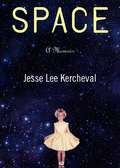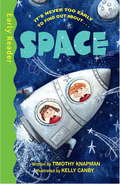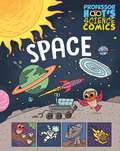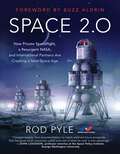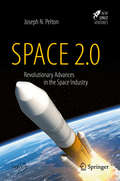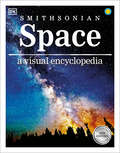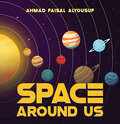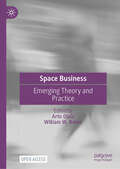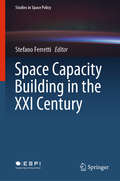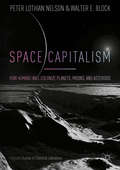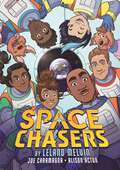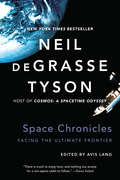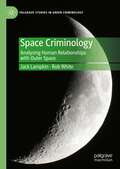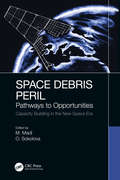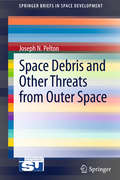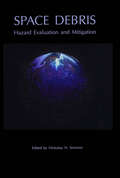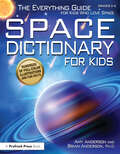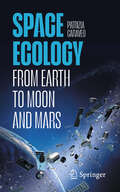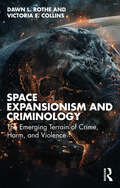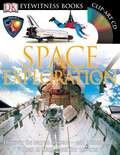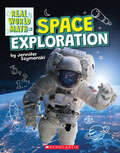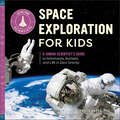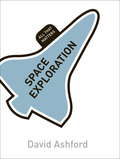- Table View
- List View
Space
by Jesse Lee KerchevalJesse Lee Kercheval opens her story in Cocoa, Florida, in 1966 as a precocious ten-year-old whose family-father, mother, two little girls-is trying to ride the Space Race's tide of optimism. But even as the rockets keep going up, the Kercheval family slowly spirals down.
Space (Early Reader Non Fiction)
by Timothy KnapmanEarly Readers are stepping stones from picture books to reading books. A green Early Reader is a first factbook.Come and explore outer space. . .There are so many things to see - ride in a space ship to visit stars, galaxies and planets!Discover the Universe around you in this brand new non fiction Early Reader from Timothy Knapman, with full colour illustrations from Kelly Canby on every page.
Space (Professor Hoot's Science Comics #6)
by Minerva BlackEvery day brings a new adventure for Professor Hoot - and a new learning experience. Have you ever gazed at the night sky and wondered what else was out there among the stars? Professor Hoot hops aboard a rocket to find out all about space travel, the wonders of our solar system and takes a side trip to Mars to join the rovers in their exploration. Discover a great expanse of stars, satellites - and science. An entertaining comic strip approach to KS1 science topics, Professor Hoot's Science Comics are accessible and full of fun. Each book is an adventure and a chance for readers to learn something new, before testing their knowledge at the end of each book in Professor Hoot's quiz. Collect each adventure: Big Machines; Dangerous Animals; Dinosaurs; Robots and AI; Space; Volcanoes and Earthquakes.
Space 2.0: How Private Spaceflight, a Resurgent NASA, and International Partners are Creating a New Space Age
by Rod PyleWe're on the cusp of new era in the great adventure of space exploration. More than a half-century ago, humanity first hurled objects into space, and almost 50 years ago, astronauts first walked on the moon. Since then, we have explored Earth's orbit with shuttles, capsules, and space stations; sent robots to Mars, Venus, Mercury, Jupiter, Saturn, and Uranus; sampled a comet; sent telescopes into orbit; and charted most of our own planet. What does the future hold? In Space 2.0, space historian Rod Pyle, in collaboration with the National Space Society, will give you an inside look at the next few decades of spaceflight and long-term plans for exploration, utilization, and settlement. No longer the exclusive domain of government entities such as NASA and other national agencies, space exploration is rapidly becoming privatized, with entrepreneurial startups building huge rocket boosters, satellites, rocket engines, asteroid probes, prospecting craft, and even commercial lunar cargo landers to open this new frontier. Research into ever more sophisticated propulsion and life support systems will soon enable the journey to Mars and destinations deeper in our solar system. As these technologies continue to move forward, there are virtually no limits to human spaceflight and robotic exploration. While the world has waited since the Apollo lunar program for the next "giant leap," these critical innovations, most of which are within our grasp with today's technology, will change the way we live, both in space and on Earth. A new space age—and with it, a new age of peace and prosperity on Earth, and settlement beyond our planet—can be ours. Speaking with key leaders of the latest space programs and innovations, Pyle shares the excitement and promise of this new era of exploration and economic development. From NASA and the Russian space agency Roscosmos, to emerging leaders in the private sector such as SpaceX, Blue Origin, Moon Express, Virgin Galactic, and many others, Space 2.0 examines the new partnerships that are revolutionizing spaceflight and changing the way we reach for the stars.
Space 2.0: Revolutionary Advances in the Space Industry (Springer Praxis Books)
by Joseph N. PeltonA true revolution has rocked the space industry, as Silicon Valley and new startup companies around the world have shaken up the status quo. This has in turn triggered a hefty response among traditional aerospace companies, launching the sector into the new Space 2.0. This book explains how and why this remarkable change has happened, starting from the industry’s origins during the Space Age and working its way to the present day. No other industry in the world has experienced the dramatic shift in technology and services as rapidly as the field of satellite services and rocket launch systems has. This book analyzes the dynamic shift over the past decade in how satellites are designed, manufactured, launched, and operated. It also turns an eye to the future, discussing the amazing feats and potential issues we can expect from this shifting arena by 2030. With its beginner-friendly writing style and plethora of illustrations, this book serves as a perfect introductory text to students and professionals alike wishing to learn more about the key trends in the field of space applications and launch systems.
Space A Visual Encyclopedia (DK Children's Visual Encyclopedias)
by DKFrom the Moon, Sun, and planets of our Solar System to space exploration, black holes, and dark matter, this completely revised and updated children&’s encyclopedia covers all you need to know about the cosmos. The most up-to-date images from space agencies such as NASA and ESA combine with info panels, timelines, interviews, diagrams, and activities you can do at home to help you understand the majesty and wonder of space. Learn about the Space Race, the Apollo Moon Landings, the Voyager craft that first probed the outer planets, the Hubble telescope, and the International Space Station (ISS) – the state-of-the-art laboratory orbiting Earth. Find out about future missions, space tourism, and the latest discoveries in the furthest reaches of our galaxy. Discover how to find constellations and where to look for stars and planets, including Venus and Mars, in the night sky. Learn how galaxies such as our Milky Way were formed. Part of a series of best-selling encyclopedias for children, Space: A Children&’s Encyclopedia is a rocket ride from the beginning of time to the near future, and from planet Earth out to the furthest reaches of the Universe.
Space Activity Lab (DK Activity Lab)
by DKDiscover the wonders of our incredible Universe.This fun, fact-filled book is brimming with exciting outdoor experiments to help budding astronomers aged 9+ explore the secrets of space. Using household items, combine astronomy with art and craft by launching your own rocket, build a moon lander to learn how astronauts touch down safely on the moon&’s surface, and make a pinhole camera to observe a solar eclipse.Packed with photography, easy-to-follow instructions, and attention to detail, Space Activity Lab will make young astronomers excited from the get-go! Each of the super-fun make-and-do projects in this book comes with simple step-by-step photographs and instructions that will inspire children&’s imagination and reveal some of the secrets of space.This children&’s craft book on space offers: - 19 hands-on projects that appeals to kids aged 9+.- Materials easily found around the home with no specialist equipment needed.- Information boxes full of fascinating facts and panel stories that explain the science throughout the book.- A clear explanation how STEM is involved in creating the project or the results of the experiment.Perfect for kids who are interested in STEM, Space Activity Lab features projects that explore everything from the Solar System to meteorites and from the Milky Way to moon buggies. Design your own orrery to understand how planets orbit the Sun, create a cardboard model to explore the phases of the moon, and for when darkness falls, there&’s a starfinder section that shows you how to spot incredible constellations in the night sky, from The Plough to Orion.More in the seriesThe Activity Lab series inspires children to get hands-on with learning by creating exciting STEM projects in their favorite subject. If you liked Space Activity Lab, then why not try Dinosaur Activity Lab for budding palaeontologists, Cardboard Activity Lab for eco-friendly recycling fun, or Great STEM Projects experiments for all budding scientists?
Space Around Us
by Ahmad Faisal AlyousufThis book talks all about the planets in our solar system, this book features a Fact Box, which gives you quick information and comparisons to planets. This book also includes fun facts. The book also briefly talks about the sun. This book has information up-to-date as of 2024.
Space Balls (Fountas & Pinnell Classroom, Guided Reading Grade 5)
by Jackie LeteraThe Ball's in Your Court What can you do with a Ping-Pong ball and a little imagination? Become a space scientist! Thousands of people already have. NIMAC-sourced textbook
Space Business: Emerging Theory and Practice
by William W. Baber Arto OjalaThis book is an academic investigation of commercial activities of firms in the space related industries and those utilizing services provided by space technology firms. These firms and their activities are part of the “New Space” concept where space related commercial activities are undertaken and funded by private firms rather than government institutions. New Space is leading to business model innovation and new theory about space business activities including upstream and downstream commercial activities. Upstream value chains include activities prior to turnover of launched systems to operators. Downstream value chains include operation of systems in space as well as the transfer, processing, and sale of space-based data and data services. The commercial activities of space business now reach into everyday lives of most humans from banking and disaster management to resource monitoring to tourism. With such broad reach, the New Space ecosystem is rapidly developing in importance and complexity.
Space Capacity Building in the XXI Century (Studies in Space Policy #22)
by Stefano FerrettiThis book, edited by the European Space Policy Institute, is the first international publication, following UNISPACE+50, to analyze how space capacity building can empower the international community towards fully accessing all the economic and societal benefits that space assets and data can offer. New innovation models are increasingly spreading across various sectors and disciplines, including space, which is becoming an integral part of many societal activities (e.g. telecoms, weather, climate change and environmental monitoring, civil protection, infrastructures, transportation and navigation, healthcare and education). The book helps readers construct their own space capacity building roadmaps, which take into account key stakeholders and also new private actors, NGOs and civil society. Starting from a policy and strategy perspective, it addresses key aspects of capacity building, including innovation and exploration, global health, climate change and resilient societies. It outlines the available options and summarizes the ideal programmatic conditions for their successful implementation. Showcasing reflections from a range of senior space professionals around the world, with their unique perspectives and solutions, it provides a rich mosaic in which various cultural and policy approaches to space are translated into actionable programs and ideas so that space may truly benefit all of humankind.
Space Capitalism: How Humans will Colonize Planets, Moons, and Asteroids (Palgrave Studies in Classical Liberalism)
by Peter Lothian Nelson Walter E. BlockThis book compares and contrasts the motivations, morality, and effectiveness of space exploration when pursued by private entrepreneurs as opposed to government. The authors advocate market-driven, private initiatives take the lead through enhanced competition and significant resources that can be allocated to the exploration and exploitation of outer space. Space travel and colonisation is analysed through the prism of economic freedom and laissez faire capitalism, in a unique and accessible book.
Space Chasers by Leland Melvin (Space Chasers by Leland Melvin)
by Leland Melvin Joe CaramagnaWhen a team of brilliant kids-turned-astronauts find themselves in serious trouble in outer space, they must work together to get back home. This is the first book in an incredible middle-grade graphic novel series created by real life astronaut, Leland Melvin!Launch into action in T-Minus 3, 2, 1… When Tia Valor takes a test on a whim for an exclusive NASA program for middle schoolers, she never thought she’d pass. After all, she never really fit in at school. In fact, she’s been skipping school most days to work at her brother’s auto shop instead. But Leland Melvin, a famed astronaut, sees potential in Tia, and before she knows it, she’s part of a team of other talented kids training to launch to an advanced space station orbiting the earth. But the perils of space are unpredictable and Tia finds herself with only half her crew and no adults around to help. Now she must rely on her instincts and the quick thinking of her fellow kid astronauts to save the space station and their lives!Created by real-life astronaut Leland Melvin, Eisner-Award nominated comic creator Joe Caramagna, and brought to brilliant life by Alison Acton, SPACE CHASERS is a space adventure like no other.
Space Chronicles: Facing the Ultimate Frontier
by Neil Degrasse Tyson Avis Lang"A compelling appeal, at just the right time, for continuing to look up."--Air & Space America's space program is at a turning point. After decades of global primacy, NASA has ended the space-shuttle program, cutting off its access to space. No astronauts will be launched in an American craft, from American soil, until the 2020s, and NASA may soon find itself eclipsed by other countries' space programs. With his signature wit and thought-provoking insights, Neil deGrasse Tyson--one of our foremost thinkers on all things space--illuminates the past, present, and future of space exploration and brilliantly reminds us why NASA matters now as much as ever. As Tyson reveals, exploring the space frontier can profoundly enrich many aspects of our daily lives, from education systems and the economy to national security and morale. For America to maintain its status as a global leader and a technological innovator, he explains, we must regain our enthusiasm and curiosity about what lies beyond our world. Provocative, humorous, and wonderfully readable, Space Chronicles represents the best of Tyson's recent commentary, including a must-read prologue on NASA and partisan politics. Reflecting on topics that range from scientific literacy to space-travel missteps, Tyson gives us an urgent, clear-eyed, and ultimately inspiring vision for the future.
Space Criminology: Analysing Human Relationships with Outer Space (Palgrave Studies in Green Criminology)
by Rob White Jack LampkinAs humans expand the frequency and scale of interactions off-planet, Space Criminology ponders the nature of crime, harm and transgression in outer space and possible responses to these. The first book of its kind, it discusses the dynamics of space crime, from those involving powerful elites through to those associated with the mundane interactions of people living and working in space. It is essential reading for anyone interested in extra-terrestrial crime, space law, and criminal justice.
Space Debris Peril: Pathways to Opportunities
by M. Madi and O. Sokolova"This book provides up-to-date knowledge of space debris and valuable insights on how to grapple with this issue from legal, technical, economical and societal aspects. I would strongly recommend that everyone who is working on space development and utilizations and even non-specialists once read this book and think over how human being should be faced with this issue." –Prof. Shinichi Nakasuka, University of Tokyo, Japan Space Debris Peril: Pathways to Opportunities takes readers through the wide spectrum of problems created by space debris – including technical, political, legal and socio-economical aspects – and suggests ways to mitigate its negative consequences and create new opportunities. With chapter contributions from authors at world-renowned universities, private or public entities, and research institutes active in the field of space debris mitigation, space policy and law, risk and resilience, liability and insurance, this book provides a comprehensive introduction to the subject helping the reader to grasp the whole picture of the current space debris remediation challenges. This book will be of interest to the scientific communities, policy makers, business developers, (re)insurers and international standards developers for space operations and orbital debris mitigation. Also, it should appeal to a broader audience among non-specialists in various sectors and the general public. Key features: Brings together interdisciplinary perspectives on the topic in one, cohesive book Chapter contributions from specialists in this interdisciplinary field from around the globe Up-to-date information with the latest developments
Space Debris and Other Threats from Outer Space
by Joseph N. PeltonThe mounting problem of space debris in low earth orbit and its threat to the operation of application satellites has been increasingly recognized as space activities increase. The efforts of the Inter Agency Space Debris Coordinating Committee (IADC) and UN COPUS have now led to international guidelines to mitigate the creation of new debris. This book discusses the technical studies being developed for active removal processes and otherwise mitigating problems of space debris, particularly in low earth orbit. This book also considers threats to space systems and the Earth that comes from natural causes such as asteroids, coronal mass ejections, and radiation. After more than half a century of space applications and explorations, the time has come to consider ways to provide sustainability for long-term space activities.
Space Debris: Hazard Evaluation and Debris
by Nickolay N. SmirnovWhen the first sputnik was launched and the space era began, few gave thought to the possible negative impact of putting satellites into orbit. In fact, man's space activity has led to the formation of a new media named "space debris," i.e. man-made objects and their fragments launched into space, currently inactive and no longer serving any useful
Space Dictionary for Kids: The Everything Guide for Kids Who Love Space
by Brian Anderson Amy AndersonPacked with hundreds of illustrated definitions about astronomy and space, Space Dictionary for Kids is certain to spark any kid's enthusiasm for the solar system and galaxy. Explore cosmology, stars and galaxies, the solar system, space exploration, and exoplanets and astrobiology. Hop on an astronomy timeline to learn the story of how primitive ancient beliefs evolved over centuries to become a high-technology science. Crack up over the humorous sidebars that expand on the topic of space with examples, explanations, diagrams, quizzes, and even short activities to enhance understanding. Use the references and further reading recommendations at the end to help find more information about astronomy, perfect for assignments or those just wanting to know more about the coolest topic in the galaxy! Divided into sections for quick access to the easy-to-understand definitions and amazing full-color illustrations, Space Dictionary for Kids is a must-have for any kid's home library!Grades 3-6NSTA Recommends
Space Ecology: From Earth to Moon and Mars
by Patrizia CaraveoThe recent entry of private entrepreneurs into the world of space has multiplied the number of services provided by instruments in orbit, resulting into a rapid and tumultuous growth of the space economy. More services translate into more launches bringing into orbit more satellites. As a result, circum-terrestrial orbits are filling up alarmingly, and we are only at the beginning of the proliferation of mega constellations that have sprung up in recent years to provide planet-wide Internet connectivity. There are neither national nor international laws for managing the number of orbiting satellites that are growing at such a dizzying rate that real orbital traffic jams are feared. We need to extend to the space around us, but also to the other bodies in the solar system, the concept of sustainable use so as not to repeat the same mistakes we have made on Earth's surface. Around our planet we need to avoid overcrowding of orbits so as not to endanger our planet's economy, which is heavily dependent on the use of satellites. Looking further afield, to the Moon and Mars, for example, we must balance resource utilization with unnecessary pollution of fragile ecosystems. Human settlements will have to respect the ecosystem of these celestial bodies that do not belong to any state but must be absolutely protected in order to prevent an interplanetary version of the tragedy of the commons, unfortunately so familiar in our planet. Particular attention must be paid to the risks of biological pollution. Explorers (both human and robotic) risk carrying terrestrial material. Similarly, handling extraterrestrial samples requires well-equipped laboratories and continuous surveillance.
Space Expansionism and Criminology: The Emerging Terrain of Crime, Harm, and Violence
by Dawn L. Rothe Victoria E. CollinsWe have entered a recent zeitgeist, the era of the "new space age", driven by billionaires, technological advancements, and a few dominating state powers. While the race to space may be said to offer "new" opportunities for "humanity", we ask, is it predicated on the same logics and historical patterns of the past? This question guides our approach and critical assessment of human expansionism into space. Space Expansionism and Criminology: The Emerging Terrain of Crime, Harm, and Violence offers readers a critical analysis of space expansionism and today’s race to space that has come to define our contemporary era. Taking a retrospective and prospective approach, we delve into the choices being made, the justifications being offered, and those excluded from the hegemonic discourse of the benefits of humans as extraplanetary beings. Space Expansionism and Criminology includes chapters on the historical roots of today’s space race, weaponization and realpolitik, space junk and debris, space mining and resource extrapolation, the burgeoning space tourism market, the manufacturing of space nostalgia from the 1950s through today, and efforts towards, and claims-making for, space colonization to save Earth and humanity.
Space Exploration (DK Eyewitness Books)
by Carole Stott Dk Publishing StaffAn informative guide to the mysteries beyond Earth and its atmosphere which offers a unique view of the history of space exploration and the daily life of astronauts.
Space Exploration (Real World Math)
by Jennifer SzymanskiGrab your space suit and get ready to use math to explore space!3 … 2 … 1 … blast off! Space scientists use math every day to explore our universe. Join a real astronomer on an amazing adventure to COUNT the planets, MEASURE the stars, ADD on the space station, and more. Then test your math skills with special You Can Do It challenges.This brand-new series demonstrates how math skills can be applied to high-interest topics and careers in Coding, Building, Tracking Animals, and Space Exploration. The K-2 math concepts include counting 1-100 with basic addition and subtraction, using the power of 10, measuring, and simple geometry. Real world scientists, architects, programmers, and mathematicians model hands-on, from-the-field experiences in a way that will make children excited to use and expand their math skills!
Space Exploration for Kids: A Junior Scientist's Guide to Astronauts, Rockets, and Life in Zero Gravity (Junior Scientists)
by Bruce BettsExplore deep space and beyondGet ready to take a thrilling journey to the farthest reaches of the universe. Space Exploration for Kids is loaded with out-of-this-world facts and eye-popping photographs that give you an inside look into the daily lives of astronauts. From learning the history of space exploration and rockets to what life is like up there, this top choice among space books for kids 6-9 will inspire you to reach for the stars.Discover what it takes to become an astronaut in this informative selection in space books for kids 6-9. Included are sections about training, how space affects the human body, and the type of work they conduct. Learn about different types of crewed spacecraft, and find out how to design your own rocket ship! Your first step toward a rocket-fueled adventure begins right now.This standout among space books for kids 6-9 includes:Reach for the stars—One of the most engaging space books for kids 6-9 takes you beyond the solar system and into deep space.Astronaut 101—From astronaut training to living in space, there's a special focus on astronauts and space travel.Learn more!—A selection of bonus materials like sidebars, fun activities, and callouts make your learning experience even more fun.Go beyond other space books for kids 6-9 with this informative book about the final frontier.
Space Exploration: All That Matters
by David AshfordAmid a century devastated by war, space exploration was perhaps mankind's greatest achievement of the twentieth century. Yet remarkably, in a world where most technology progresses constantly, space exploration appears to have gone backwards. Man has not returned to the moon since 1972; the space shuttle programme has finished and not been replaced; much-vaunted promises of space tourism have not become realistic.In this remarkable book, David Ashford looks back at the story of space exploration, identifying the factors that were a driving force behind the eye-catching programmes of the cold war, and showing how now new driving forces are needed. Using his own extensive experience as a practitioner and researcher of space exploration, Ashford then outlines a new, realistic roadmap for achieving the new space age soon and at an affordable cost.This accessible and readable book will appeal both to students and general readers, giving a fascinating introduction to space exploration - and what matters most about it.
